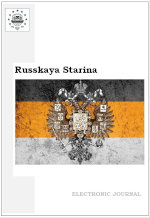1 June 14, 2023
Articles
1. Aleksey R. Mikhaylov
Coal from the Moscow Area and its Role in the Country’s Economy before the Russian Revolution of 1917
Russkaya Starina. 2023. 14(1): 4-8.
Number of views: 45 Download in PDF
2. Mark R. LysenkoRusskaya Starina. 2023. 14(1): 4-8.
Abstract:
The article discusses the topic of coal mining and its use in the Moscow area before the Russian Revolution of 1917. Coal was one of the main sources of energy in Russia at that time, it used in industry, transport and household needs. The Moscow area had significant coal reserves, and its extraction was an important branch of the region’s economy. The author analyzes the history and features of coal mining near Moscow, as well as its use in various sectors of the economy. The main companies engaged in coal mining in the region are characterized, the technologies and equipment used in its extraction and transportation are described.
The article discusses the topic of coal mining and its use in the Moscow area before the Russian Revolution of 1917. Coal was one of the main sources of energy in Russia at that time, it used in industry, transport and household needs. The Moscow area had significant coal reserves, and its extraction was an important branch of the region’s economy. The author analyzes the history and features of coal mining near Moscow, as well as its use in various sectors of the economy. The main companies engaged in coal mining in the region are characterized, the technologies and equipment used in its extraction and transportation are described.
Number of views: 45 Download in PDF
The Formation of the Kremenchug Bridgehead and its Role in the Encirclement of the South-Western Front in 1941
Russkaya Starina. 2023. 14(1): 9-21.
Number of views: 42 Download in PDF
3. Nicholay W. Mitiukov, Yury L. KimRusskaya Starina. 2023. 14(1): 9-21.
Abstract:
The article deals with the defense of the left bank of the Dnieper River in August-September 1941. The author singles out the creation of Kremenchug bridgehead as the main reason for the Kiev encirclement. This thesis confirms the analysis of the general strategic situation in the Ukrainian direction, established by the time of the formation and consolidation of the Kremenchug bridgehead. The author examines in detail the chronology of the battle for the left bank, which mainly unfolded not over the entire front, but on separate bridgeheads. Comparing the German plans with the current operational situation in the area from Kanev to Zaporozhye, the author has concluded that the Red Army, pulling together large forces to fight on local breaks, in conjunction with the little interaction between the commands of armies, fronts and the Supreme Command, has created conditions conducive to the successful breakthrough of the enemy on his main direction. As secondary factors affecting the defense, the author considered the general problems of the Red Army at the end of summer – the lack of ammunition, weakness of mobile units, and “staff hysteria”. The study is based on the documents of the Central Archive of the Ministry of Defense of the Russian Federation and German archival documents in the custody of the National Archives and Records Administration of the United States, as well as sources of personal origin and historiography on the subject under study.
The article deals with the defense of the left bank of the Dnieper River in August-September 1941. The author singles out the creation of Kremenchug bridgehead as the main reason for the Kiev encirclement. This thesis confirms the analysis of the general strategic situation in the Ukrainian direction, established by the time of the formation and consolidation of the Kremenchug bridgehead. The author examines in detail the chronology of the battle for the left bank, which mainly unfolded not over the entire front, but on separate bridgeheads. Comparing the German plans with the current operational situation in the area from Kanev to Zaporozhye, the author has concluded that the Red Army, pulling together large forces to fight on local breaks, in conjunction with the little interaction between the commands of armies, fronts and the Supreme Command, has created conditions conducive to the successful breakthrough of the enemy on his main direction. As secondary factors affecting the defense, the author considered the general problems of the Red Army at the end of summer – the lack of ammunition, weakness of mobile units, and “staff hysteria”. The study is based on the documents of the Central Archive of the Ministry of Defense of the Russian Federation and German archival documents in the custody of the National Archives and Records Administration of the United States, as well as sources of personal origin and historiography on the subject under study.
Number of views: 42 Download in PDF
The Fleet of the Sarapul Timber Plant in 1940–1956
Russkaya Starina. 2023. 14(1): 22-28.
Number of views: 49 Download in PDF
4. Pavel E. SemashkaRusskaya Starina. 2023. 14(1): 22-28.
Abstract:
At present, it is hardly possible to compile a complete list of the USSR vessels used in the 1940s–1950s, due to the assignment of the enterprises which had fleets to a wide range of ministries and departments. Even the Register of the USSR could not collect information about all vessels, because it had no real mechanisms to make the enterprises submit this information. So, obviously, the compilation of a complete list of ships, if possible, should begin with a description of the fleets of individual enterprises. The fleet of Sarapulsk Timber Plant has never been its core asset, performing only auxiliary functions, simplifying the timber supply. Apparently, the wood processing plant carried out its activity in close cooperation with the “Kamlesosplav” trust, which is proved, among other things, by the transfer of individual vessels both in one direction and backwards. During the war and postwar years, the basis of the enterprise’s fleet consisted of second-hand vessels. The exception was half-gliders, which were delivered directly from the shipyard. The organization did not receive its first modern boat until 1954.
At present, it is hardly possible to compile a complete list of the USSR vessels used in the 1940s–1950s, due to the assignment of the enterprises which had fleets to a wide range of ministries and departments. Even the Register of the USSR could not collect information about all vessels, because it had no real mechanisms to make the enterprises submit this information. So, obviously, the compilation of a complete list of ships, if possible, should begin with a description of the fleets of individual enterprises. The fleet of Sarapulsk Timber Plant has never been its core asset, performing only auxiliary functions, simplifying the timber supply. Apparently, the wood processing plant carried out its activity in close cooperation with the “Kamlesosplav” trust, which is proved, among other things, by the transfer of individual vessels both in one direction and backwards. During the war and postwar years, the basis of the enterprise’s fleet consisted of second-hand vessels. The exception was half-gliders, which were delivered directly from the shipyard. The organization did not receive its first modern boat until 1954.
Number of views: 49 Download in PDF
Modern Russian Historiography of the Political Crisis of Autumn 1993 (based on the RSCI Database)
Russkaya Starina. 2023. 14(1): 29-43.
Number of views: 42 Download in PDF
5. Anton V. Averyanov, Georgy A. ShvidkoyRusskaya Starina. 2023. 14(1): 29-43.
Abstract:
The article analyzes the modern Russian historiography of the constitutional crisis of September – October 1993 in Moscow. The author considers articles published in journals and collections included in the Russian Science Citation Index. Using methods of quantitative and qualitative analysis, the author identifies and characterizes seven major topics that have been most actively studied in historical science. Researchers paid the most attention to the problem of regions and the interaction of the center with them. They also paid an attention to the legal aspects of the topic: institute of presidency in the legal system of the country, peculiarities of adoption and characteristic features of the Constitution, etc. Besides, the article examines the historical sources used by the authors (they mainly referred to scientific literature on the issue, press data and published documents of state authorities) and makes a conclusion about the necessity of introducing new sources and more active use of the existing ones (archival and statistical data). The positive (increased attention to the problems of regions, the role of the press in the conflict) and negative sides of modern historiography on the subject (poor coverage of the role of social movements and political parties in the conflict) are noted.
The article analyzes the modern Russian historiography of the constitutional crisis of September – October 1993 in Moscow. The author considers articles published in journals and collections included in the Russian Science Citation Index. Using methods of quantitative and qualitative analysis, the author identifies and characterizes seven major topics that have been most actively studied in historical science. Researchers paid the most attention to the problem of regions and the interaction of the center with them. They also paid an attention to the legal aspects of the topic: institute of presidency in the legal system of the country, peculiarities of adoption and characteristic features of the Constitution, etc. Besides, the article examines the historical sources used by the authors (they mainly referred to scientific literature on the issue, press data and published documents of state authorities) and makes a conclusion about the necessity of introducing new sources and more active use of the existing ones (archival and statistical data). The positive (increased attention to the problems of regions, the role of the press in the conflict) and negative sides of modern historiography on the subject (poor coverage of the role of social movements and political parties in the conflict) are noted.
Number of views: 42 Download in PDF
On the Theory and Practice of Toponymic Policy in Rostov-on-Don in the 1990s–2010s
Russkaya Starina. 2023. 14(1): 44-54.
Number of views: 48 Download in PDF
6. Russkaya Starina. 2023. 14(1): 44-54.
Abstract:
The article deals with the theory and practice of the implementation of toponymic policy in Rostov-on-Don at the turn of the century, in the 1990s–2010s. The idea of the formation of a mechanism for the implementation of actions to consolidate historical memory in the toponymic space is put forward. The historiography on the chosen topic is analyzed. The sources used are: the legal and regulatory basis and documents of municipal authorities in the field of implementation of toponymic policy. The mechanism of action of the City Interdepartmental Commission on the Names of Socially Significant Places, which is a key institution for the implementation of toponymic policy in Rostov-on-Don, has been reconstructed. The positive and negative aspects of the implementation of toponymic policy within a single city are revealed. The characteristic of the ways of its possible development is given.
The article deals with the theory and practice of the implementation of toponymic policy in Rostov-on-Don at the turn of the century, in the 1990s–2010s. The idea of the formation of a mechanism for the implementation of actions to consolidate historical memory in the toponymic space is put forward. The historiography on the chosen topic is analyzed. The sources used are: the legal and regulatory basis and documents of municipal authorities in the field of implementation of toponymic policy. The mechanism of action of the City Interdepartmental Commission on the Names of Socially Significant Places, which is a key institution for the implementation of toponymic policy in Rostov-on-Don, has been reconstructed. The positive and negative aspects of the implementation of toponymic policy within a single city are revealed. The characteristic of the ways of its possible development is given.
Number of views: 48 Download in PDF







